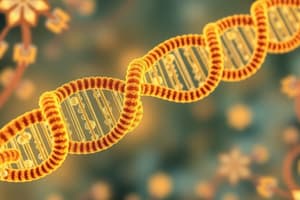Podcast
Questions and Answers
Which of the following correctly describes the relationship between amino acids, polypeptides, and proteins?
Which of the following correctly describes the relationship between amino acids, polypeptides, and proteins?
- Amino acids, polypeptides, and proteins are unrelated molecules.
- Polypeptides are composed of proteins, which then form amino acids.
- Proteins are composed of polypeptides, which in turn are composed of amino acids. (correct)
- Amino acids are composed of proteins, which assemble into polypeptides.
Transcription is the process where RNA is synthesized using DNA as a template, and it occurs in the cytoplasm.
Transcription is the process where RNA is synthesized using DNA as a template, and it occurs in the cytoplasm.
False (B)
What is the significance of the codon AUG in the genetic code?
What is the significance of the codon AUG in the genetic code?
start codon
In translation, _____ RNA carries the genetic information from the nucleus to the ribosome.
In translation, _____ RNA carries the genetic information from the nucleus to the ribosome.
Match each type of point mutation with its description:
Match each type of point mutation with its description:
Flashcards
RNA vs. DNA
RNA vs. DNA
RNA has ribose, is single-stranded, uses uracil. DNA has deoxyribose, is double-stranded, uses thymine. Both are nucleic acids, use a sugar-phosphate backbone, and have 4 bases.
Types of RNA
Types of RNA
mRNA carries genetic code, tRNA transfers amino acids, rRNA forms ribosomes.
Transcription
Transcription
Transcription is DNA to RNA, occurs in the nucleus, uses RNA polymerase.
Amino Acids to Proteins
Amino Acids to Proteins
Signup and view all the flashcards
Translation
Translation
Signup and view all the flashcards
Study Notes
- RNA differs from DNA in three ways: it is single-stranded, contains ribose sugar instead of deoxyribose, and uses uracil (U) in place of thymine (T).
- RNA and DNA are similar in that they are both nucleic acids, composed of nucleotide monomers, and involved in genetic information storage and transfer.
Types of RNA
- Messenger RNA (mRNA) carries genetic information from DNA to the ribosomes.
- Transfer RNA (tRNA) brings amino acids to the ribosome during protein synthesis.
- Ribosomal RNA (rRNA) is a component of ribosomes, the site of protein synthesis.
Importance of Proteins
- Proteins are crucial for various functions, including catalyzing biochemical reactions (enzymes), providing structural support, transporting molecules, and facilitating movement.
- Examples of proteins: enzymes, structural proteins (collagen), transport proteins (hemoglobin), and motor proteins.
Transcription
- Transcription is the process of synthesizing RNA from a DNA template.
- It occurs in the nucleus in eukaryotes.
- RNA polymerase is the enzyme involved.
Amino Acids, Polypeptides, and Proteins
- Amino acids are the building blocks of proteins.
- Polypeptides are chains of amino acids linked by peptide bonds.
- Proteins are functional molecules made of one or more polypeptide chains.
Genetic Code
- The genetic code is a set of rules by which information encoded in genetic material (DNA or RNA) is translated into proteins by living cells.
Codons
- A codon is a sequence of three nucleotides (triplet) that codes for a specific amino acid or a stop signal during protein synthesis.
- There are 64 different codons.
- There are 20 amino acids.
Start and Stop Codons
- AUG is the start codon, which initiates protein synthesis and codes for methionine.
- Stop codons (UAA, UAG, UGA) signal the termination of translation.
Translation
- Translation is the process of synthesizing a polypeptide chain from an mRNA template.
- It occurs in the ribosomes in the cytoplasm.
- It involves mRNA, tRNA, and rRNA.
Mutation
- A mutation is a change in the nucleotide sequence of DNA.
Point Mutation
- A point mutation is a change in a single nucleotide base in DNA.
- Types include: substitutions (replacement of one nucleotide with another), insertions (addition of a nucleotide), and deletions (removal of a nucleotide).
Frameshift Mutation
- A frameshift mutation is an insertion or deletion of nucleotides that alters the reading frame of the genetic message, leading to a completely different amino acid sequence downstream of the mutation.
Studying That Suits You
Use AI to generate personalized quizzes and flashcards to suit your learning preferences.




